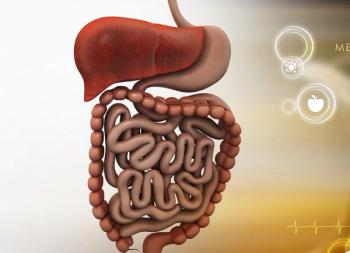
Early Data Show Epcoritamab Induces Responses in High-Risk DLBCL in First Line
High response rates were noted in a phase 1/2 trial of the bispecific antibody epcoritamab to treat first-line, high-risk diffuse large B-cell lymphoma.
Results from the phase 1/2 EPCORE NHL-2 trial (NCT04663347) in patients with high-risk diffuse large B-cell lymphoma (DLBCL) demonstrate efficacy and safety of the bispecific antibody epcoritamab in the first-line treatment setting, according to data presented at the 2022 American Society of Clinical Oncology (ASCO) Annual Meeting.1
Of note, investigators reported an overall response rate of 100%, a complete metabolic response rate of 77%, and a partial metabolic response of 23%.
In the study arm, patients with previously untreated DLBCL received subcutaneous epcoritamab and standard-of-care rituximab (Rituxan), cyclophosphamide, hydroxydaunorubicin hydrochloride (doxorubicin hydrochloride), vincristine (Oncovin) and prednisone (R-CHOP) for 6 cycles of 21 days, followed by epcoritamab monotherapy for 1 year.
“This drug is well suited for combination therapy due to its mechanism of action, which is distinct from that of components of standard-of-care R-CHOP,” Lead author Lorenzo Falchi, MD, a medical oncologist at Memorial Sloan Kettering Cancer Center in New York, NY, said during the presentation of the data. The mechanism of action and safety profile of epcoritamab differs from standard treatments, and epcoritamab is well suited for use in combinations and in earlier lines of therapy, according to the study investigators.
Eligible patients had newly diagnosed CD20+ DLBCL, International Prognostic Index (IPI) score of 3 or greater, and ECOG performance status from 0 to 2. Median age was 66 years (range, 19-82) and the majority (55%) were male.
“Notably, over 20% of the cohort had either double- or triple-hit lymphoma,” Falchi said. Specifically, 9% had double-hit lymphoma and 15% had triple-hit lymphoma.
During the dose-escalation portion (n = 10), 4 patients received subcutaneous epcoritamab at 24 mg and 6 patients received 48-mg epcoritamab, in combination with R-CHOP for cycles 1 to 6. In this portion of the study, the primary objectives were dose limiting toxicity/safety and tolerability and the secondary objective was antitumor activity.
In the dose-expansion portion (n = 23), patients received 48 mg of epcoritamab plus R-CHOP; the primary objective was antitumor activity.
The median follow-up was 6.9 months (range, 0.8-14.7) and patients received a median of 9 cycles of treatment. Seventy-three percent of patients continue to undergo treatment, 18% have discontinued treatment, and 9% have completed treatment.
Treatment-emergent adverse events (TEAEs) in ≥20% of patients were anemia (60%), neutropenia (60%), cytokine release syndrome (CRS; 51%), injection-site reaction (42%), nausea (45%), constipation (33%), and pyrexia (33%).
Investigators noted that treatment discontinuation was observed in 18% of patients. AEs of special interest included grade 1/2 CRS (48%), grade 3 CRS (3%), and grade 2 immune effector cell-associated neurotoxicity syndrome (3%), which resolved in 4 days. Most CRS events occurred in the first cycle and resolved after a median of 2 days (range, 1-4). Five patients (15%) with CRS received tocilizumab (Actemra).
R-CHOP remains the mainstay of therapy and can achieve long-term disease control in nearly 90% of patients presenting with limited-stage disease and in up to 60% of those presenting with advanced stages. Historically, patients with high-risk DLBCL have poor outcomes with an overall 4-year survival rate of 55% when treated with current standard-of-care therapy.2,3 Epcoritamab binds to CD3 on T cells and CD20 on B cells to induce T-cell—mediated killing of CD20+ B cells. Novel therapies such as this one could potentially improve outcomes for patients with high-risk disease.
This updated data set with longer follow-up shows promising response rates and safety profile with no new safety signals detected, wrote the investigators.
“Importantly, the majority of CRS events were of low grade that did not lead to treatment discontinuation. These results support further evaluation of epcoritamab in combination with R-CHOP in this population,” concluded Falchi.
References
- Falchi L, Offner F, Belada D, et al. First-line treatment (Tx) with subcutaneous (SC) epcoritamab (epco) + R-CHOP in patients (pts) with high-risk diffuse large B-cell lymphoma (DLBCL): Phase 1/2 data update. J Clin Oncol. 2022;40(suppl 16):7523. doi:10.1200/JCO.2022.40.16_suppl.7523.
- Sehn LH, Berry B, Chhanabhai M, et al. The revised International Prognostic Index (R-IPI) is a better predictor of outcome than the standard IPI for patients with diffuse large B-cell lymphoma treated with R-CHOP. Blood. 2007;109(5):1857-1861. doi:10.1182/blood-2006-08-0382573.
- Susanibar-Adaniya S, Barta SK. 2021 Update on Diffuse large B-cell lymphoma: A review of current data and potential applications on risk stratification and management. Am J Hematol. 2021;96(5):617-629. doi:10.1002/ajh.26151
Newsletter
Stay up to date on recent advances in the multidisciplinary approach to cancer.

























































































